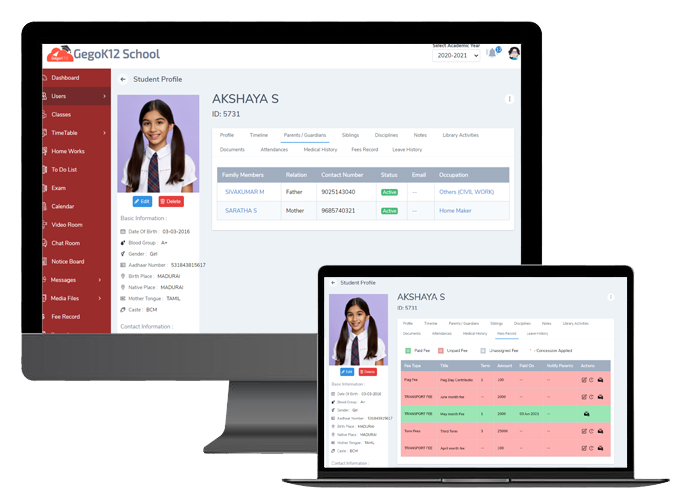A school management system is a collection of tools that allows a school to manage all of its operations from a single dashboard. It’s a digital system that handles everything like admissions, attendance, payment, scheduling, and even online classes. We’ve already gone through the benefits of school management software, so we’ll limit this talk to all you wanted to know about school ERP costs.
But first and foremost, you must understand what you are paying for…
What exactly is the distinction between a Student Information System (SIS) and a School Management System (SMS)?
The terms are frequently used interchangeably, but the distinction is important because the pricing will clearly differ.
A subset of school management software is the SIS (Student Information System). A student information system (SIS) is a fully computerized system that is stored in the cloud and can be accessed with the proper credentials from anywhere. The SIS records all of the student’s information, which is divided into modules. Features like student enrollment, admission, billing, financial aid, tests, and results can be added as needed.
Pricing for a School Management System
There are several school management systems available on the market. Many of them are advertised as free, but the majority are paid or subscription-based. Some are appropriate for small groups, while others are appropriate for multi-school groups. A little more information on the various options
- Management system for free schools
If you are a small school with fewer than 50 students, it is free. However, as your usage grows, you will be required to pay to continue using the software. The goal of free school management systems is usually to give educational institutions a first look at the product and get them acquainted with it.
2. School management software that is open source
What it implies is open-source software. Educational institutions can buy the software, download it, and modify the code as needed to make it fit their needs. The software will need to be uploaded to the school’s servers. The school must have its own technical team in order to use open-source software. Because maintenance and data backup are ongoing requirements, it is unsuitable for educational institutions.
3. Flat pricing (per institution per year) –
Many firms have introduced flat pricing, charging per institution, and granting unlimited user licenses, to avoid the aforesaid complication in pricing. With the advent of cloud computing, hosting costs have been reduced, allowing vendors to offer more flexibility in terms of user licenses. Institutions are charged a yearly flat fee. Depending on the vendor and institution, prices range from hundreds of dollars to millions of dollars.
4. Pricing for a package
The majority of software providers in the market will choose a combination pricing strategy that combines all three pricing models mentioned above. In the case of combination pricing, you can compute the total cost of ownership by adding up all of the costs you’ll have to pay the vendor over the following 3 to 5 years if the software is used. Find out how various factors such as student numbers, number of institutions, features, and so on affect the software’s pricing this year and in the future.
5. Pricing is dependent on the number of users
A range of price models is available for subscription-based paid school administration software.
If you want parents to have User IDs in addition to students and staff, the price may increase. Many subscription-based models charge solely by the number of students, not by the Ids, so read the contract carefully.
This is the most cost-effective alternative for larger educational customize institutions.
Additional Costs are frequently neglected:
Email/SMS: Bulk Email and SMS are commonly used to communicate with students and parents. Both of these have a monthly payment that will be recurring. Check with the vendor to see if this is included in the package or how much it will cost.
Most SaaS products are hosted by the source, however, there is a separate hosting price if you are purchasing an Enterprise package.
Mobile App: This is often an extra expense, so check with the vendor to see whether it is included in the package price.
Other costs, such as barcode/RFID (for library administration) or GPS tracking (for transportation management), necessitate additional hardware and installation. Data backup is an important consideration that must be factored into the total price of the package.
It can be difficult to choose between the various possibilities once you’ve determined that your institution needs school administration software. To get answers to all of your questions, contact our specialists. Leading educational institutions and group institutions in Tamil Nadu, India, have chosen Gegok12 as their ERP solution.
We are known for our cutting-edge ERP systems, which are developed by a big team of technically-skilled employees who are guided by educational specialists and technological developers.
Conclusion
The various complexity involved in purchasing school administration software should now be evident to you after reading the preceding essay. With this knowledge, you may now assess the various software options presented by companies. If you require additional information about the subject, Get in touch with us

